How pharmacy benefit managers power medication affordability
As drug prices continue to rise, Optum Rx is creating innovative solutions that provide affordable access to medications. And yet, there is still a lot of confusion and misinformation around the role of pharmacy benefit managers (PBMs).
Most prominent are the different legislative inquiries investigating PBM activities.1 In addition, the pharmaceutical makers have tried to position PBMs as "middlemen" responsible for driving up the cost of drugs.2 In fact, pharma has by far the biggest lobbying operation in the U.S., spending $374 million in 2022 — nearly 70% more than the next ranked industry.3
Since only drug manufacturers have the power to set drug prices, PBMs are the only counterweight to high drug costs in the health care system.
In order to bring some clarity to this discussion, let’s look at the facts.
What research tells us about the role of a PBM in health care
There are several valuable resources we can consult about the roles of PBMs. We will focus here on 3 very recent sources of information:
- A Brookings Institute report from September 2023 that reviews the most prominent changes proposed for PBMs in the current policy debates (“Brookings”)4
- Senate testimony from March 2023 describing the history and function of PBMs by Professor Lawton Robert Burns of the Wharton School of Business, based on his 2022 book The Healthcare Value Chain: Demystifying the Role of GPOs and PBMs (“Burns")5
- A paper written by former Chief Economist for the Council of Economic Advisers, Casey B. Mulligan, PhD. in July 2022 that was published through the University of Chicago Department of Economics and quantifies the economic impact of PBMs (“Mulligan”)6
All of these documents are worth exploring in detail, but we can highlight some basic findings.
- If PBMs didn’t perform utilization management or price negotiations, plan sponsors would likely have to do it themselves. The alternative would be unacceptable waste and increased cost. Mulligan calculates that having PBMs do this work contributes $145 billion per year to the economy, even after the cost of paying the PBMs.14
- PBM bargaining power requires purchasing volume to achieve leverage over product suppliers. Robust PBM buying power has helped them to negotiate lower drug prices and keep annual price growth low.12,13
- PBM formularies promote quality care through the decisions made by Pharmacy and Therapeutics (P&T) Committees. They consist primarily of clinicians who are charged with reviewing the scientific evidence for each drug — before any cost considerations.15
- PBMs promote competition among drug manufacturers. Makers of similar products compete by granting price concessions to get on PBM formularies.16,17
- The various criticisms of PBMs and their suggested remedies consistently fail on close analysis. Burns finds that most criticisms don’t hold up to the available evidence.10 Brookings concludes that in many cases the proposed solutions might be viable. But they might either be ineffective, or even make the situation worse.11
A recent development extends this principle to the new biosimilar versions of the popular biologic drug, Humira®. Optum Rx was the first PBM to announce additional biosimilar versions of Humira to its standard formularies so clients and members could benefit from lower net-cost options.
Learnings: Aligning with clients' needs
The marketplace ensures that if PBMs were not accomplishing these goals, their customers would become dissatisfied and leave.18,19 But in fact, the Optum Rx client retention rate consistently exceeds 98%, while 9 out of 10 clients express their satisfaction with our clinical insights and recommendations.20
In summary, when these experts take a hard look at PBMs, they do not see an industry in dire need of an overhaul. Rather, they see a robust, evolving array of programs and services that are successfully addressing their client’s needs.
Next, we’ll look at a particular example of how PBMs are closely aligned with their clients’ needs: generic drugs.
The rise of generic drugs
We all know that generic drugs save money, but it’s a little shocking to realize just how much.
$2.6 trillion of generic savings in 10 years
This graph reflects savings from 2008 through 2021 based on brand vs. generic prices.
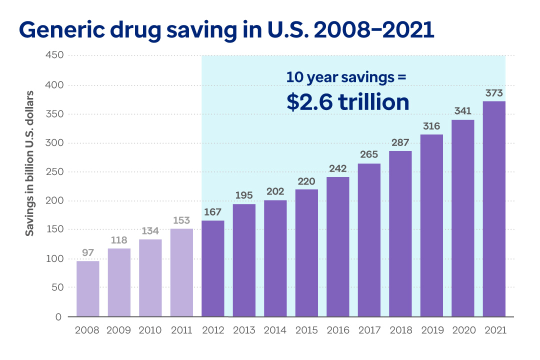
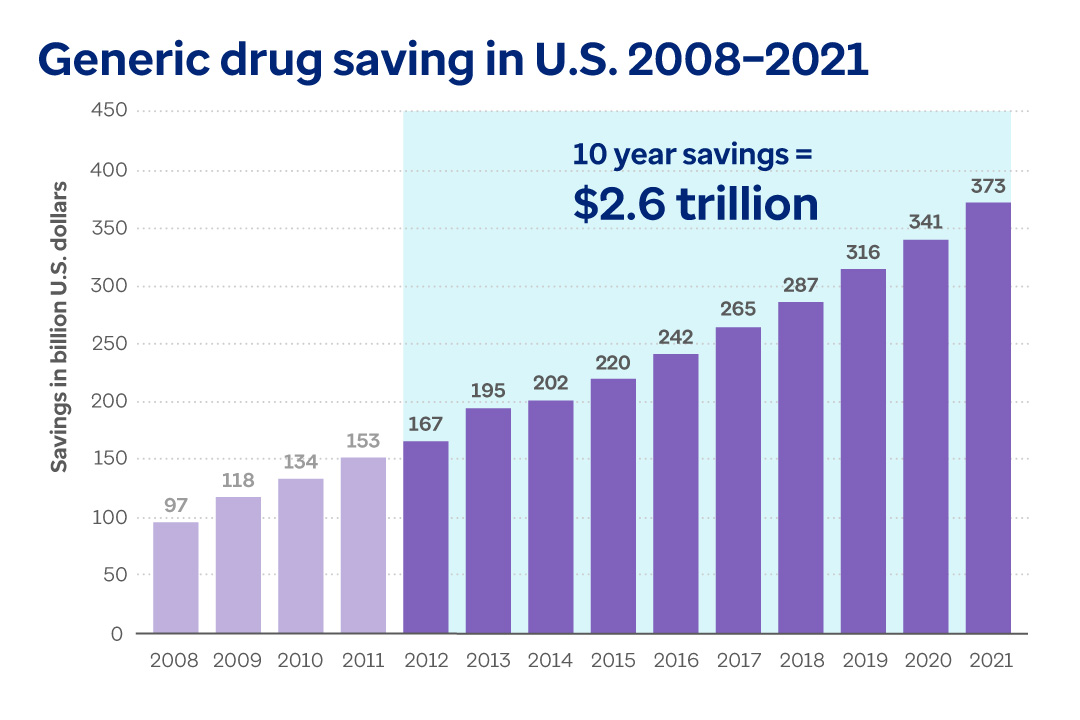
Bar chart depicting the increase of savings on generic drugs between 2008 and 2021.
In 2008 savings from the use of generic drugs equaled $97 billion. Savings grew to $118B in 2009, $134B in 2010, $153B in 2011, $167B in 2012, $195B in 2013, $202B in 2014, $220B in 2015, $242B in 2016, $265B in 2017, $287 in 2018, $316 in 2019, $341B in 2020, and $373 in 2021. In the 10 years from 2012 to 2021 total savings amounted to $2.6 trillion.
[image adapted from: Statista.Savings through generic drug usage in the U.S. 2008-2021. Published October 6, 2022.]
Both PBMs and their clients are aligned on the need to implement benefit designs that promote generics. The reason is simple: the programs save money and help promote better health outcomes.
Mulligan estimates $16 billion per year in generic drug savings that flow to plan sponsors and members can be directly attributed to PBM strategies.21
PBMs create drug cost savings that matter
It’s clear that the overall savings numbers from generics are impressive. But that doesn’t keep detractors from combing through multiple PBM formularies to find isolated examples of drugs that might be less expensive if sourced through another vendor.22
But the real issue is not the price of individual drugs. What matters is the total cost of the drugs that make the biggest impact on plan sponsor costs as well as the total cost management of a drug class. This means more than just price, although that is key. But it also extends to managing how these drugs are used, including generics and other alternative forms.
Some of the largest employer costs of all are due to chronic disease. A majority of Americans (60%) have at least one chronic condition, while 42% have 2 or more. Chronic conditions account for $1.1 trillion just in direct health care costs every year in the U.S.23
Chronic conditions are leading causes of death and disability in the U.S.24 But the good news is that many chronic diseases are treatable with prescription drugs.
For example, high blood pressure, coronary artery disease and HIV can be successfully managed when patients routinely take prescribed medications.25
Unfortunately, many people do not take their medications as they should, citing cost as a primary reason.26
Optum Rx is directly addressing this problem by always driving lowest net cost across our book of business.
Let’s explore this further by examining prices for some commonly used chronic medications. We have selected drugs for high blood pressure, high cholesterol, diabetes and depression.
High blood pressure, high cholesterol and diabetes are well-known and highly prevalent chronic conditions.27 While depression doesn’t appear on most lists of chronic conditions, it is very common and can be long-lasting.28 Trazodone is an antidepressant used in treating major depressive disorders.29
We recently compared drugs for 4 key chronic conditions ranked by their percentage of claims filed in 2022 across the U.S. Prices are shown for Optum Rx and for a non-traditional online drug vendor that emphasizes low prices.
Prices from Optum Rx vs. online drug vendor
This graphic illustrates lower member prices for each drug compared to the online drug vendor:
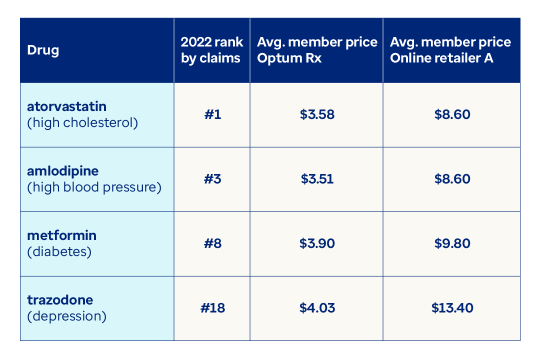
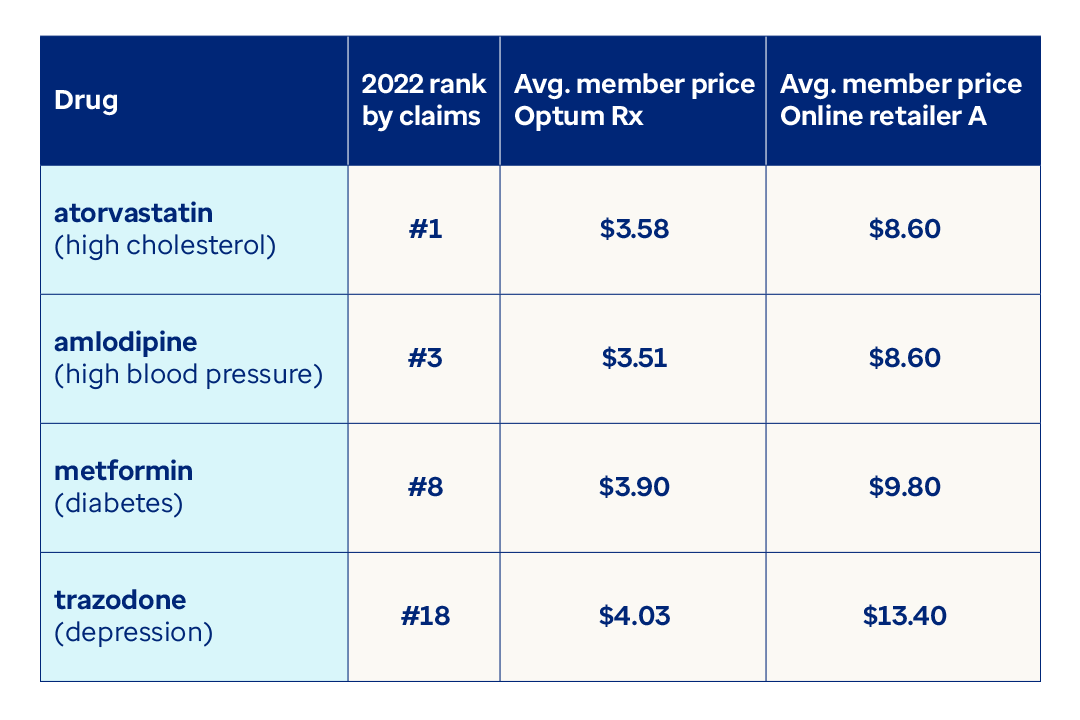
Table shows 2022 rank by claims, avg. member price Optum Rx and Online retailer A of drugs
Atorvastatin, used to treat high cholesterol, ranked #1 in number of claims in 2022. The Optum Rx average member price of atorvastatin is $3.58 compared to $8.60 for the online vendor.
• Amlodipine, used to treat high blood pressure, ranked #3 in claims in 2022. The Optum Rx average member price of amlodipine is $3.51 compared to $8.60 for the online vendor.
• Metformin, used to treat diabetes, ranked #8 in claims in 2022. The Optum Rx average member price of metformin is $3.90 compared to $9.80 for the online vendor.
• Trazodone, used to treat depression, ranked #18 in claims in 2022. The Optum Rx average member price for trazodone is $4.03 compared to $13.40 for the online vendor.
[Sources: 2023 Optum Rx price data. Definitive Healthcare. Top 20 outpatient prescription medications. Published December 30, 2022. Publicly available prices from CostPlus.com.]
As we can see, Optum Rx prices are significantly lower for these critical medications. For this list of common medications, the third-party vendor prices are 169% higher on average.
In general, Optum Rx pricing wins nearly 90% of the time against the cash market, delivering significant value for our clients and their members.
In short, when it comes to treatments for conditions that affect millions of people and drive most employer costs, Optum Rx routinely delivers a far lower price. And lower prices matter.
Bringing people and prices together
Low prices are a good thing, but perhaps even more important is making sure that members know they can pay less. Here we can look at some examples of Optum Rx tools designed to do just that. Each tool uses the same claims and benefits structure database used by our customer service professionals. But now it’s available when and how any member needs it.
Cost-saving consumer solutions from Optum Rx
Here are 4 cutting-edge solutions designed to help members get the lowest price for their prescriptions.
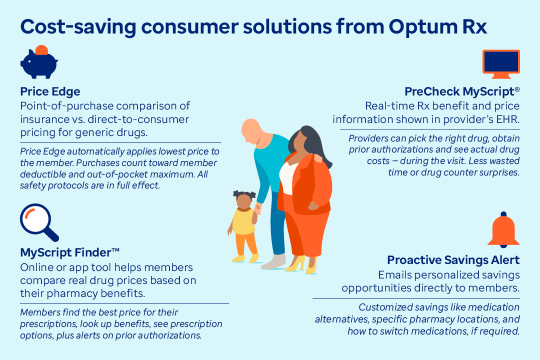
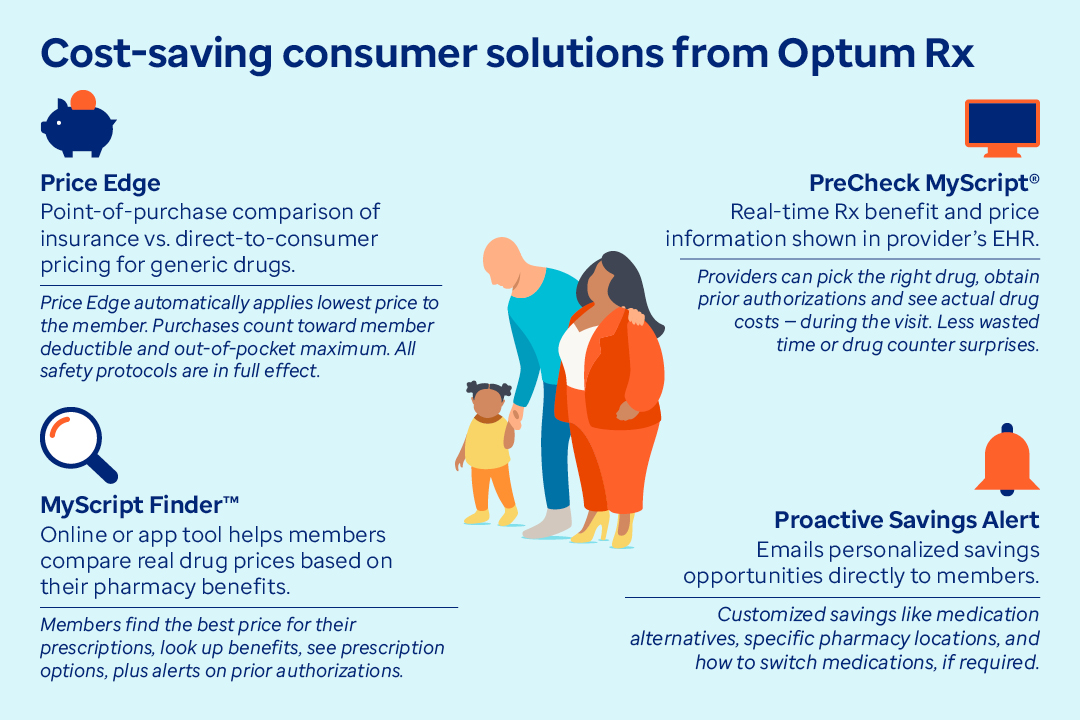
Illustrated graphic, descriptions of Optum Rx programs
This graphic illustrates 4 cost-saving consumer solutions from Optum Rx:
1. Price Edge is a point-of-purchase comparison of insurance vs. direct-to-consumer pricing for generic drugs. Price Edge automatically applies the lowest price to the member. Purchases count toward member deductible and out-of-pocket maximum. All safety protocols are in full effect.
2. PreCheck MyScript offers real-time Rx benefit and price information that is shown in a provider’s EHR. Providers can pick the right drug, obtain prior authorizations and see actual drug costs — during the visit. This results in less wasted time and fewer drug counter surprises.
3. MyScript Finder™ is an online or app tool that helps members compare real drug prices based on their pharmacy benefits. Members find the best price for their prescriptions, look up benefits, see prescription options and receive alerts on prior authorizations.
4. Proactive Savings Alert emails personalized savings opportunities directly to members. Customized savings can include medication alternatives, specific pharmacy locations and how to switch medications, if required
Additional Optum Rx affordability strategies
We know that higher medication adherence may lead to better health outcomes and lower total healthcare expenses.30 And, looking specifically at diabetes, research shows that there is a direct correlation between member cost share and diabetes medication adherence.31,32
In line with our first-to-market initiatives for Price Edge and biosimilars, Optum Rx will continue to evolve the PBM industry. Effective January 1, 2024 (subject to any required regulatory approval), Optum Rx will be moving several preferred short- and long-acting insulins to Tier One on standard formularies.
This move for insulin continues our unfolding consumer affordability strategy. In 2022, Optum Rx announced a suite of optional Critical Drug Affordability modules. Each module represents a class of critical and life-sustaining medications and sets a maximum member cost share of $35 for a monthly supply.
Similarly, by encouraging clients to keep members’ monthly insulin cost share at $35 or less, we can help make it easier for members to stick to their regimen. While pharmaceutical companies set the price of prescription drugs, including insulin, our negotiating power empowers us to deliver savings for consumers.
Our commitment to you
Optum Rx is accountable for consistently delivering savings on prescription drugs. However, our responsibilities go well beyond merely dispensing affordable drugs.
Everyone deserves a simple, affordable, personalized health experience — a holistic and connected approach to health. We’re here to help create those connections.
We support our members throughout their entire health care journey, which means keeping a close eye on their treatment. Our systems monitor claims every day to find opportunities to enhance medication, improve case management or intervene if needed, especially for people with the most complex conditions.
Ultimately, our goal is nothing less than to help create a simpler, more intelligent, adaptive health care system — one that has the power to change everyone’s life for the better.
Related content

Lowest net cost and your bottom line

Empowering clients with more choice and transparency

How to control drug costs without compromising care
Sources
- KFF News. PBMs, the Brokers Who Control Drug Prices, Finally Get Washington’s Attention. Published May 11, 2023. Accessed September 25, 2023.
- PhRMA. New analysis shows PBMs use fees as a profit center. Published September 18, 2023. Accessed October 9, 2023.
- Statista Research Department. Leading lobbying industries in the United States in 2022, by total lobbying spending. Published April 5, 2023. Accessed October 12, 2023.
- Brookings Institute. A brief look at current debates about pharmacy benefit managers. Published September 7, 2023. Accessed September 26, 2023.
- Testimony before the United States Senate Committee on Finance Hearing on “Pharmacy Benefit Managers and the Prescription Drug Supply Chain.” Lawton Robert Burns, Ph.D., MBA. Published March 30, 2023. Accessed September 28, 2023.
- Casey B. Mulligan. University of Chicago Department of Economics. The Value of Pharmacy Benefit Management. Published July 2022. Accessed September 15, 2023.
- Brookings Institute. A brief look at current debates about pharmacy benefit managers. Published September 7, 2023. Accessed September 26, 2023.
- Testimony before the United States Senate Committee on Finance Hearing on “Pharmacy Benefit Managers and the Prescription Drug Supply Chain.” Lawton Robert Burns, Ph.D., MBA. Published March 30, 2023. Accessed September 28, 2023.
- Casey B. Mulligan. University of Chicago Department of Economics. The Value of Pharmacy Benefit Management. Published July 2022. Accessed September 15, 2023.
- Testimony before the United States Senate Committee on Finance Hearing on “Pharmacy Benefit Managers and the Prescription Drug Supply Chain.” Lawton Robert Burns, Ph.D., MBA. Published March 30, 2023. Accessed September 28, 2023.
- Brookings Institute. A brief look at current debates about pharmacy benefit managers. Published September 7, 2023. Accessed September 26, 2023.
- Testimony before the United States Senate Committee on Finance Hearing on “Pharmacy Benefit Managers and the Prescription Drug Supply Chain.” Lawton Robert Burns, Ph.D., MBA. Published March 30, 2023. Accessed September 28, 2023.
- Casey B. Mulligan. University of Chicago Department of Economics. The Value of Pharmacy Benefit Management. Published July 2022. Accessed September 15, 2023.
- Ibid.
- Testimony before the United States Senate Committee on Finance Hearing on “Pharmacy Benefit Managers and the Prescription Drug Supply Chain.” Lawton Robert Burns, Ph.D., MBA. Published March 30, 2023. Accessed September 28, 2023.
- Ibid.
- Casey B. Mulligan. University of Chicago Department of Economics. The Value of Pharmacy Benefit Management. Published July 2022. Accessed September 15, 2023.
- Ibid.
- Testimony before the United States Senate Committee on Finance Hearing on “Pharmacy Benefit Managers and the Prescription Drug Supply Chain.” Lawton Robert Burns, Ph.D., MBA. Published March 30, 2023. Accessed September 28, 2023.
- 2022 Optum Rx post QPR survey of clients and consultants.
- Casey B. Mulligan. University of Chicago Department of Economics. The Value of Pharmacy Benefit Management. Published July 2022. Accessed September 15, 2023.
- Wall Street Journal. Generic Drugs Should Be Cheap, but Insurers Are Charging Thousands of Dollars for Them. Published September 11, 2023. Accessed September 15, 2023.
- Kaiser Permanente. Better care for chronic conditions. Accessed September 23, 2023.
- Centers for Disease Control and Prevention (CDC). About Chronic Diseases. Last reviewed July 21, 2022. Accessed September 20, 2023.
- Centers for Disease Control and Prevention (CDC). Overcoming Barriers to Medication Adherence for Chronic Diseases. Last reviewed February 28, 2018. Accessed September 23, 2023.
- Ibid.
- Centers for Disease Control and Prevention (CDC). About Chronic Diseases. Last reviewed July 21, 2022. Accessed September 20, 2023.
- StatPearls. Major Depressive Disorder. Last updated April 10, 2023. Accessed September 25, 2023.
- StatPearls. Trazodone. Last updated July 10, 2022. Accessed September 25, 2023.
- Health Policy. Association between copayment, medication adherence and outcomes in the management of patients with diabetes and heart failure. Published April 2017. Accessed September 29, 2023.
- Ibid.
- Journal of Managed Care and Specialty Pharmacy. Novel Type 2 Diabetes Medication Access and Effect of Patient Cost Sharing. Published September 24, 2018. Accessed September 29, 2023.

